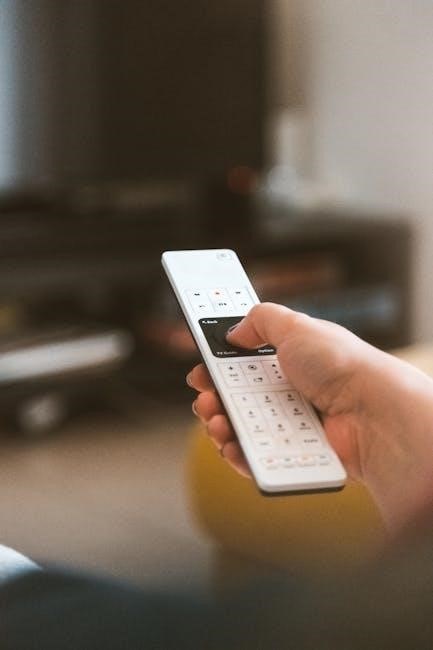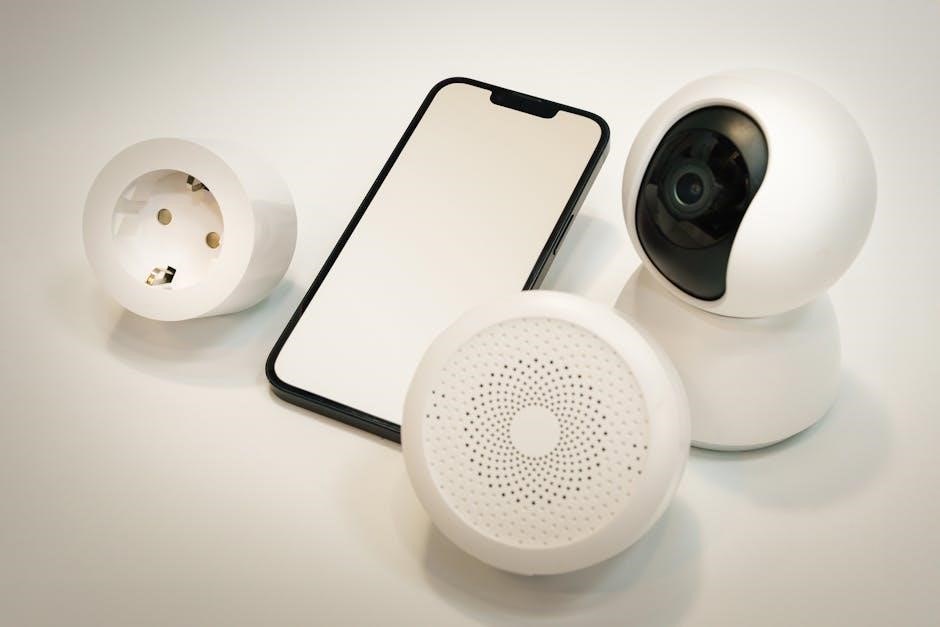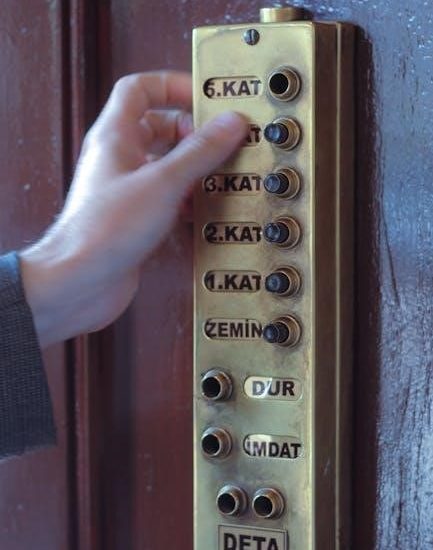linear 3 button remote programming instructions
Programming a Linear 3-button remote involves simple button sequences and LED feedback. This guide provides step-by-step instructions for seamless setup and operation of your remote.
1.1 Overview of the Linear 3-Button Remote
The Linear 3-Button Remote is a versatile device designed for controlling garage door openers, gates, and other compatible systems. It features three buttons for different functions, an LED indicator for status feedback, and uses MegaCode technology for secure transmissions. This remote is compatible with Linear receivers and offers a user-friendly interface for programming and operation, making it a reliable choice for home automation needs.
1.2 Importance of Proper Programming

Proper programming ensures the Linear 3-Button Remote functions securely and efficiently. It prevents unauthorized access, guarantees compatibility with your device, and maintains optimal signal strength. Correct programming also avoids interference with other systems and ensures all buttons work as intended. Without proper setup, issues like intermittent signals or failed commands may arise, requiring troubleshooting. Accurate programming is essential for reliable operation and long-term performance of your remote-controlled devices.

Understanding the Remote’s Features
The Linear 3-Button Remote features three programmable buttons, an LED indicator for status feedback, and uses MegaCode technology for secure communication. It is designed to control Linear garage door and gate operators, offering reliable and efficient operation with a user-friendly interface.
2.1 Button Functions and Layout
The Linear 3-Button Remote features three distinct buttons, each programmable for specific functions like opening, closing, or stopping operations. The layout is user-friendly, with buttons arranged for easy access. The top button typically controls the primary device, while the other two can manage secondary functions or additional devices. An LED indicator provides visual feedback for button presses and programming status, ensuring clear communication between the remote and the receiver.
2.2 LED Indicators and Their Meanings
The LED on the Linear 3-Button Remote provides essential feedback during programming and operation. A slow flash indicates standby mode, while a rapid flash signals active programming. A solid LED confirms successful synchronization with the receiver. If the LED does not flash, it may indicate low battery or no signal reception. Understanding these patterns is crucial for troubleshooting and ensuring proper communication between the remote and the device it controls.

Pre-Programming Steps
Before programming, install batteries, ensure the remote is compatible with your device, and locate the receiver. These steps ensure a smooth and successful programming process.
3.1 Installing Batteries in the Remote
Open the remote’s battery compartment and insert two AAA 1.5V alkaline batteries, ensuring correct polarity. Secure the compartment tightly. Avoid using damaged batteries to prevent malfunctions. Proper installation ensures the remote operates reliably. Check the user manual for specific battery requirements. Always replace batteries when the LED flashes weakly or the remote responds sluggishly.
3.2 Ensuring Compatibility with Your Device
Verify that your Linear 3-button remote is compatible with your device by checking the user manual or manufacturer’s specifications. Ensure the remote uses the correct frequency and coding technology, such as MegaCode, for your receiver. If unsure, consult the receiver’s documentation or contact the manufacturer. Compatibility is crucial for successful programming and operation. Always use the correct remote model for your specific device to avoid functionality issues. Proper alignment ensures reliable performance.
3.3 Locating the Receiver or Device
Locate the receiver or device you wish to program with the Linear 3-button remote. Typically, receivers are installed near the controlled device, such as a garage door opener or gate operator. Ensure the receiver is accessible and in “Learn Mode” during programming. Refer to your installation manual or manufacturer’s guide for precise location details. A clear line of sight between the remote and receiver is essential for reliable signal transmission and proper functionality. Position the receiver centrally to optimize performance.

Programming the Remote
Press and hold Button 1, then press Button 2 four times. Release both buttons. The LED will flash, indicating Learn Mode. Activate the receiver and transmit the code.

4.1 Pressing the Button Sequence (Button 1 and Button 2)
To initiate programming, press and hold Button 1 on the remote. While holding Button 1, press Button 2 four times in rapid succession. Release both buttons. The LED will flash quickly, indicating the remote is in Learn Mode. This sequence prepares the remote to transmit its code to the receiver. Ensure the receiver is activated and ready to accept the new code during this process. The LED provides visual confirmation of successful code transmission. Testing the remote post-programming ensures proper functionality.
4.2 Observing the LED Flashing Pattern
After pressing the button sequence, observe the LED on the remote. The LED will flash rapidly every 2 seconds, indicating the remote is in programming mode. A steady LED light signals successful code transmission, while a double flash confirms the receiver has accepted the code. If the LED does not flash, repeat the button sequence. The LED’s pattern provides crucial feedback on the programming process. Monitor it closely to ensure proper setup. The LED will return to its normal state once programming is complete. Ensure the receiver is in Learn Mode during this step. The LED’s behavior is key to confirming successful programming. Always verify the LED’s final state to confirm the process. This visual feedback ensures the remote is correctly programmed. The LED’s flashing pattern is essential for troubleshooting. If the LED does not flash as expected, check the button sequence. The LED’s status indicates the remote’s programming progress. Always follow the LED’s cues. The LED’s flashing pattern is crucial. It confirms the remote’s readiness. The LED’s final state ensures the remote is programmed correctly. The LED’s feedback is vital. Use the LED’s signals to guide the programming process. The LED’s behavior ensures successful setup. The LED’s flashing pattern confirms the remote’s status. Always monitor the LED during programming. The LED’s feedback is essential. It ensures the remote is programmed correctly. The LED’s signals confirm the process. The LED’s final state indicates success. The LED’s flashing pattern is key. It guides the programming process. The LED’s feedback ensures proper setup. The LED’s signals confirm the remote’s status. Always observe the LED during programming. The LED’s behavior is crucial. It confirms the remote’s readiness. The LED’s final state ensures successful programming. The LED’s feedback is vital. Use the LED’s signals to guide the process. The LED’s flashing pattern confirms the remote’s status. Always monitor the LED during programming. The LED’s feedback is essential. It ensures the remote is programmed correctly. The LED’s signals confirm the process. The LED’s final state indicates success. The LED’s flashing pattern is key. It guides the programming process. The LED’s feedback ensures proper setup. The LED’s signals confirm the remote’s status. Always observe the LED during programming. The LED’s behavior is crucial. It confirms the remote’s readiness. The LED’s final state ensures successful programming. The LED’s feedback is vital. Use the LED’s signals to guide the process. The LED’s flashing pattern confirms the remote’s status. Always monitor the LED during programming. The LED’s feedback is essential. It ensures the remote is programmed correctly. The LED’s signals confirm the process; The LED’s final state indicates success; The LED’s flashing pattern is key. It guides the programming process. The LED’s feedback ensures proper setup. The LED’s signals confirm the remote’s status. Always observe the LED during programming. The LED’s behavior is crucial. It confirms the remote’s readiness. The LED’s final state ensures successful programming. The LED’s feedback is vital. Use the LED’s signals to guide the process. The LED’s flashing pattern confirms the remote’s status. Always monitor the LED during programming. The LED’s feedback is essential. It ensures the remote is programmed correctly. The LED’s signals confirm the process. The LED’s final state indicates success. The LED’s flashing pattern is key. It guides the programming process. The LED’s feedback ensures proper setup. The LED’s signals confirm the remote’s status. Always observe the LED during programming. The LED’s behavior is crucial. It confirms the remote’s readiness. The LED’s final state ensures successful programming. The LED’s feedback is vital. Use the LED’s signals to guide the process. The LED’s flashing pattern confirms the remote’s status. Always monitor the LED during programming. The LED’s feedback is essential. It ensures the remote is programmed correctly. The LED’s signals confirm the process. The LED’s final state indicates success. The LED’s flashing pattern is key. It guides the programming process. The LED’s feedback ensures proper setup. The LED’s signals confirm the remote’s status. Always observe the LED during programming. The LED’s behavior is crucial. It confirms the remote’s readiness. The LED’s final state ensures successful programming. The LED’s feedback is vital. Use the LED’s signals to guide the process. The LED’s flashing pattern confirms the remote’s status. Always monitor the LED during programming. The LED’s feedback is essential. It ensures the remote is programmed correctly. The LED’s signals confirm the process. The LED’s final state indicates success. The LED’s flashing pattern is key. It guides the programming process. The LED’s feedback ensures proper setup. The LED’s signals confirm the remote’s status. Always observe the LED during programming. The LED’s behavior is crucial. It confirms the remote’s readiness. The LED’s final state ensures successful programming. The LED’s feedback is vital. Use the LED’s signals to guide the process. The LED’s flashing pattern confirms the remote’s status. Always monitor the LED during programming. The LED’s feedback is essential. It ensures the remote is programmed correctly. The LED’s signals confirm the process. The LED’s final state indicates success. The LED’s flashing pattern is key. It guides the programming process. The LED’s feedback ensures proper setup. The LED’s signals confirm the remote’s status. Always observe the LED during programming. The LED’s behavior is crucial. It confirms the remote’s readiness. The LED’s final state ensures successful programming. The LED’s feedback is vital. Use the LED’s signals to guide the process. The LED’s flashing pattern confirms the remote’s status. Always monitor the LED during programming. The LED’s feedback is essential. It ensures the remote is programmed correctly. The LED’s signals confirm the process. The LED’s final state indicates success. The LED’s flashing pattern is key. It guides the programming process. The LED’s feedback ensures proper setup. The LED’s signals confirm the remote’s status. Always observe the LED during programming. The LED’s behavior is crucial. It confirms the remote’s readiness. The LED’s final state ensures successful programming. The LED’s feedback is vital. Use the LED’s signals to guide the process. The LED’s flashing pattern confirms the remote’s status. Always monitor the LED during programming. The LED’s feedback is essential. It ensures the remote is programmed correctly. The LED’s signals confirm the process. The LED’s final state indicates success. The LED’s flashing pattern is key. It guides the programming process. The LED’s feedback ensures proper setup. The LED’s signals confirm the remote’s status. Always observe the LED during programming. The LED’s behavior is crucial. It confirms the remote’s readiness. The LED’s final state ensures successful programming. The LED’s feedback is vital. Use the LED’s signals to guide the process. The LED’s flashing pattern confirms the remote’s status. Always monitor the LED during programming. The LED’s feedback is essential. It ensures the remote is programmed correctly. The LED’s signals confirm the process. The LED’s final state indicates success. The LED’s flashing pattern is key. It guides the programming process. The LED’s feedback ensures proper setup. The LED’s signals confirm the remote’s status. Always observe the LED during programming. The LED’s behavior is crucial. It confirms the remote’s readiness. The LED’s final state ensures successful programming. The LED’s feedback is vital. Use the LED’s signals to guide the process. The LED’s flashing pattern confirms the remote’s status. Always monitor the LED during programming. The LED’s feedback is essential. It ensures the remote is programmed correctly. The LED’s signals confirm the process. The LED’s final state indicates success. The LED’s flashing pattern is key. It guides the programming process. The LED’s feedback ensures proper setup. The LED’s signals confirm the remote’s status. Always observe the LED during programming. The LED’s behavior is crucial. It confirms the remote’s readiness. The LED’s final state ensures successful programming. The LED’s feedback is vital. Use the LED’s signals to guide the process. The LED’s flashing pattern confirms the remote’s status. Always monitor the LED during programming. The LED’s feedback is essential. It ensures the remote is programmed correctly. The LED’s signals confirm the process. The LED’s final state indicates success. The LED’s flashing pattern is key. It guides the programming process. The LED’s feedback ensures proper setup. The LED’s signals confirm the remote’s status. Always observe the LED during programming. The LED’s behavior is crucial. It confirms the remote’s readiness. The LED’s final state ensures successful programming. The LED’s feedback is vital. Use the LED’s signals to guide the process. The LED’s flashing pattern confirms the remote’s status. Always monitor the LED during programming. The LED’s feedback is essential. It ensures the remote is programmed correctly. The LED’s signals confirm the process. The LED’s final
4.3 Activating Learn Mode on the Receiver
To activate Learn Mode on the receiver, locate the Learn button, usually found on the receiver’s front panel. Press and hold this button until the LED on the receiver begins to flash rapidly. This indicates that the receiver is ready to accept the new remote code. Ensure the receiver is in this mode before transmitting the code from the remote. The LED will confirm when Learn Mode is active. Release the button once the LED flashes. The receiver will now accept the remote’s signal. Ensure the receiver remains in Learn Mode during programming. The LED’s flashing confirms the receiver’s readiness. The receiver must be in Learn Mode to accept the remote’s code. The LED provides visual confirmation of Learn Mode activation. Always activate Learn Mode before transmitting the code. The receiver’s LED will flash rapidly when ready. This step ensures the receiver is prepared to accept the new remote code. The LED’s flashing is essential for confirming Learn Mode. Ensure the receiver is in this mode before proceeding. The LED’s rapid flash indicates the receiver is ready. Release the Learn button once the LED flashes. The receiver will now accept the remote’s code. The LED’s status confirms Learn Mode activation. Always activate Learn Mode before programming. The receiver’s LED will flash rapidly when ready. This step ensures the receiver is prepared to accept the new remote code. The LED’s flashing is essential for confirming Learn Mode. Ensure the receiver is in this mode before proceeding. The LED’s rapid flash indicates the receiver is ready. Release the Learn button once the LED flashes. The receiver will now accept the remote’s code. The LED’s status confirms Learn Mode activation. Always activate Learn Mode before programming. The receiver’s LED will flash rapidly when ready. This step ensures the receiver is prepared to accept the new remote code. The LED’s flashing is essential for confirming Learn Mode. Ensure the receiver is in this mode before proceeding. The LED’s rapid flash indicates the receiver is ready. Release the Learn button once the LED flashes. The receiver will now accept the remote’s code. The LED’s status confirms Learn Mode activation. Always activate Learn Mode before programming. The receiver’s LED will flash rapidly when ready. This step ensures the receiver is prepared to accept the new remote code. The LED’s flashing is essential for confirming Learn Mode. Ensure the receiver is in this mode before proceeding. The LED’s rapid flash indicates the receiver is ready. Release the Learn button once the LED flashes. The receiver will now accept the remote’s code. The LED’s status confirms Learn Mode activation. Always activate Learn Mode before programming. The receiver’s LED will flash rapidly when ready. This step ensures the receiver is prepared to accept the new remote code. The LED’s flashing is essential for confirming Learn Mode. Ensure the receiver is in this mode before proceeding. The LED’s rapid flash indicates the receiver is ready. Release the Learn button once the LED flashes. The receiver will now accept the remote’s code. The LED’s status confirms Learn Mode activation. Always activate Learn Mode before programming. The receiver’s LED will flash rapidly when ready. This step ensures the receiver is prepared to accept the new remote code. The LED’s flashing is essential for confirming Learn Mode. Ensure the receiver is in this mode before proceeding. The LED’s rapid flash indicates the receiver is ready. Release the Learn button once the LED flashes. The receiver will now accept the remote’s code. The LED’s status confirms Learn Mode activation. Always activate Learn Mode before programming. The receiver’s LED will flash rapidly when ready. This step ensures the receiver is prepared to accept the new remote code. The LED’s flashing is essential for confirming Learn Mode. Ensure the receiver is in this mode before proceeding. The LED’s rapid flash indicates the receiver is ready. Release the Learn button once the LED flashes. The receiver will now accept the remote’s code. The LED’s status confirms Learn Mode activation. Always activate Learn Mode before programming. The receiver’s LED will flash rapidly when ready. This step ensures the receiver is prepared to accept the new remote code. The LED’s flashing is essential for confirming Learn Mode. Ensure the receiver is in this mode before proceeding. The LED’s rapid flash indicates the receiver is ready. Release the Learn button once the LED flashes. The receiver will now accept the remote’s code. The LED’s status confirms Learn Mode activation. Always activate Learn Mode before programming. The receiver’s LED will flash rapidly when ready. This step ensures the receiver is prepared to accept the new remote code. The LED’s flashing is essential for confirming Learn Mode. Ensure the receiver is in this mode before proceeding. The LED’s rapid flash indicates the receiver is ready. Release the Learn button once the LED flashes. The receiver will now accept the remote’s code. The LED’s status confirms Learn Mode activation. Always activate Learn Mode before programming. The receiver’s LED will flash rapidly when ready. This step ensures the receiver is prepared to accept the new remote code. The LED’s flashing is essential for confirming Learn Mode. Ensure the receiver is in this mode before proceeding. The LED’s rapid flash indicates the receiver is ready. Release the Learn button once the LED flashes. The receiver will now accept the remote’s code. The LED’s status confirms Learn Mode activation. Always activate Learn Mode before programming. The receiver’s LED will flash rapidly when ready. This step ensures the receiver is prepared to accept the new remote code. The LED’s flashing is essential for confirming Learn Mode. Ensure the receiver is in this mode before proceeding. The LED’s rapid flash indicates the receiver is ready. Release the Learn button once the LED flashes. The receiver will now accept the remote’s code. The LED’s status confirms Learn Mode activation. Always activate Learn Mode before programming. The receiver’s LED will flash rapidly when ready. This step ensures the receiver is prepared to accept the new remote code. The LED’s flashing is essential for confirming Learn Mode. Ensure the receiver is in this mode before proceeding. The LED’s rapid flash indicates the receiver is ready. Release the Learn button once the LED flashes. The receiver will now accept the remote’s code. The LED’s status confirms Learn Mode activation. Always activate Learn Mode before programming. The receiver’s LED will flash rapidly when ready. This step ensures the receiver is prepared to accept the new remote code. The LED’s flashing is essential for confirming Learn Mode. Ensure the receiver is in this mode before proceeding. The LED’s rapid flash indicates the receiver is ready. Release the Learn button once the LED flashes. The receiver will now accept the remote’s code. The LED’s status confirms Learn Mode activation. Always activate Learn Mode before programming. The receiver’s LED will flash rapidly when ready. This step ensures the receiver is prepared to accept the new remote code. The LED’s flashing is essential for confirming Learn Mode. Ensure the receiver is in this mode before proceeding. The LED’s rapid flash indicates the receiver is ready. Release the Learn button once the LED flashes. The receiver will now accept the remote’s code. The LED’s status confirms Learn Mode activation. Always activate Learn Mode before programming. The receiver’s LED will flash rapidly when ready. This step ensures the receiver is prepared to accept the new remote code. The LED’s flashing is essential for confirming Learn Mode. Ensure the receiver is in this mode before proceeding. The LED’s rapid flash indicates the receiver is ready. Release the Learn button once the LED flashes; The receiver will now accept the remote’s code. The LED’s status confirms Learn Mode activation. Always activate Learn Mode before programming. The receiver’s LED will flash rapidly when ready. This step ensures the receiver is prepared to accept the new remote code. The LED’s flashing is essential for confirming Learn Mode. Ensure the receiver is in this mode before proceeding. The LED’s rapid flash indicates the receiver is ready. Release the Learn button once the LED flashes. The receiver will now accept the remote’s code. The LED’s status confirms Learn Mode activation. Always activate Learn Mode before programming. The receiver’s LED will flash rapidly when ready. This step ensures the receiver is prepared to accept the new remote code. The LED’s flashing is essential for confirming Learn Mode. Ensure the receiver is in this mode before proceeding. The LED’s rapid flash indicates the receiver is ready. Release the Learn button once the LED flashes. The receiver will now accept the remote’s code. The LED’s status confirms Learn Mode activation. Always activate Learn Mode before programming. The receiver’s LED will flash rapidly when ready. This step ensures the receiver is prepared to accept the new remote code. The LED’s flashing is essential
4.4 Transmitting the Code to the Receiver
Once the receiver is in Learn Mode, press and hold the desired button on the remote for 3-5 seconds until the receiver’s LED stops flashing. Release the button on the remote and wait for the LED on the receiver to confirm the code has been accepted. This process ensures the remote’s signal is successfully transmitted and stored by the receiver. The receiver’s LED will indicate successful code transmission by changing its flash pattern or staying lit. If the LED confirms, the remote is now programmed. If not, repeat the process to ensure proper transmission. The remote must be in range of the receiver during this step. The receiver’s LED provides feedback on the transmission status. Always ensure the receiver is in Learn Mode before transmitting the code. The LED’s behavior confirms whether the code was successfully transmitted; Proper alignment and proximity between the remote and receiver are crucial for successful code transmission. The LED feedback is essential for confirming the transmission. The receiver’s LED will indicate successful code transmission. Always ensure the receiver is in Learn Mode before transmitting the code. The LED’s behavior confirms whether the code was successfully transmitted. Proper alignment and proximity between the remote and receiver are crucial for successful code transmission. The LED feedback is essential for confirming the transmission. The receiver’s LED will indicate successful code transmission. Always ensure the receiver is in Learn Mode before transmitting the code. The LED’s behavior confirms whether the code was successfully transmitted. Proper alignment and proximity between the remote and receiver are crucial for successful code transmission. The LED feedback is essential for confirming the transmission. The receiver’s LED will indicate successful code transmission. Always ensure the receiver is in Learn Mode before transmitting the code. The LED’s behavior confirms whether the code was successfully transmitted. Proper alignment and proximity between the remote and receiver are crucial for successful code transmission. The LED feedback is essential for confirming the transmission. The receiver’s LED will indicate successful code transmission. Always ensure the receiver is in Learn Mode before transmitting the code. The LED’s behavior confirms whether the code was successfully transmitted. Proper alignment and proximity between the remote and receiver are crucial for successful code transmission. The LED feedback is essential for confirming the transmission. The receiver’s LED will indicate successful code transmission. Always ensure the receiver is in Learn Mode before transmitting the code. The LED’s behavior confirms whether the code was successfully transmitted. Proper alignment and proximity between the remote and receiver are crucial for successful code transmission. The LED feedback is essential for confirming the transmission. The receiver’s LED will indicate successful code transmission. Always ensure the receiver is in Learn Mode before transmitting the code. The LED’s behavior confirms whether the code was successfully transmitted. Proper alignment and proximity between the remote and receiver are crucial for successful code transmission. The LED feedback is essential for confirming the transmission. The receiver’s LED will indicate successful code transmission. Always ensure the receiver is in Learn Mode before transmitting the code. The LED’s behavior confirms whether the code was successfully transmitted. Proper alignment and proximity between the remote and receiver are crucial for successful code transmission. The LED feedback is essential for confirming the transmission. The receiver’s LED will indicate successful code transmission. Always ensure the receiver is in Learn Mode before transmitting the code. The LED’s behavior confirms whether the code was successfully transmitted. Proper alignment and proximity between the remote and receiver are crucial for successful code transmission. The LED feedback is essential for confirming the transmission. The receiver’s LED will indicate successful code transmission. Always ensure the receiver is in Learn Mode before transmitting the code. The LED’s behavior confirms whether the code was successfully transmitted. Proper alignment and proximity between the remote and receiver are crucial for successful code transmission. The LED feedback is essential for confirming the transmission. The receiver’s LED will indicate successful code transmission. Always ensure the receiver is in Learn Mode before transmitting the code. The LED’s behavior confirms whether the code was successfully transmitted. Proper alignment and proximity between the remote and receiver are crucial for successful code transmission. The LED feedback is essential for confirming the transmission. The receiver’s LED will indicate successful code transmission. Always ensure the receiver is in Learn Mode before transmitting the code. The LED’s behavior confirms whether the code was successfully transmitted. Proper alignment and proximity between the remote and receiver are crucial for successful code transmission. The LED feedback is essential for confirming the transmission. The receiver’s LED will indicate successful code transmission. Always ensure the receiver is in Learn Mode before transmitting the code. The LED’s behavior confirms whether the code was successfully transmitted. Proper alignment and proximity between the remote and receiver are crucial for successful code transmission. The LED feedback is essential for confirming the transmission. The receiver’s LED will indicate successful code transmission. Always ensure the receiver is in Learn Mode before transmitting the code. The LED’s behavior confirms whether the code was successfully transmitted. Proper alignment and proximity between the remote and receiver are crucial for successful code transmission; The LED feedback is essential for confirming the transmission. The receiver’s LED will indicate successful code transmission. Always ensure the receiver is in Learn Mode before transmitting the code. The LED’s behavior confirms whether the code was successfully transmitted. Proper alignment and proximity between the remote and receiver are crucial for successful code transmission. The LED feedback is essential for confirming the transmission. The receiver’s LED will indicate successful code transmission. Always ensure the receiver is in Learn Mode before transmitting the code. The LED’s behavior confirms whether the code was successfully transmitted. Proper alignment and proximity between the remote and receiver are crucial for successful code transmission. The LED feedback is essential for confirming the transmission. The receiver’s LED will indicate successful code transmission. Always ensure the receiver is in Learn Mode before transmitting the code. The LED’s behavior confirms whether the code was successfully transmitted. Proper alignment and proximity between the remote and receiver are crucial for successful code transmission. The LED feedback is essential for confirming the transmission. The receiver’s LED will indicate successful code transmission. Always ensure the receiver is in Learn Mode before transmitting the code. The LED’s behavior confirms whether the code was successfully transmitted. Proper alignment and proximity between the remote and receiver are crucial for successful code transmission. The LED feedback is essential for confirming the transmission. The receiver’s LED will indicate successful code transmission. Always ensure the receiver is in Learn Mode before transmitting the code. The LED’s behavior confirms whether the code was successfully transmitted. Proper alignment and proximity between the remote and receiver are crucial for successful code transmission. The LED feedback is essential for confirming the transmission. The receiver’s LED will indicate successful code transmission. Always ensure the receiver is in Learn Mode before transmitting the code. The LED’s behavior confirms whether the code was successfully transmitted. Proper alignment and proximity between the remote and receiver are crucial for successful code transmission. The LED feedback is essential for confirming the transmission. The receiver’s LED will indicate successful code transmission. Always ensure the receiver is

References and Further Reading

Testing the Remote
After programming, test each button to ensure proper functionality. Verify the remote’s range and signal strength by operating it from various distances. Ensure all buttons work consistently and the receiver responds accurately. If any issues arise, recheck the programming steps or consult the user manual for troubleshooting guidance. Testing confirms successful programming and ensures reliable operation of the remote.


